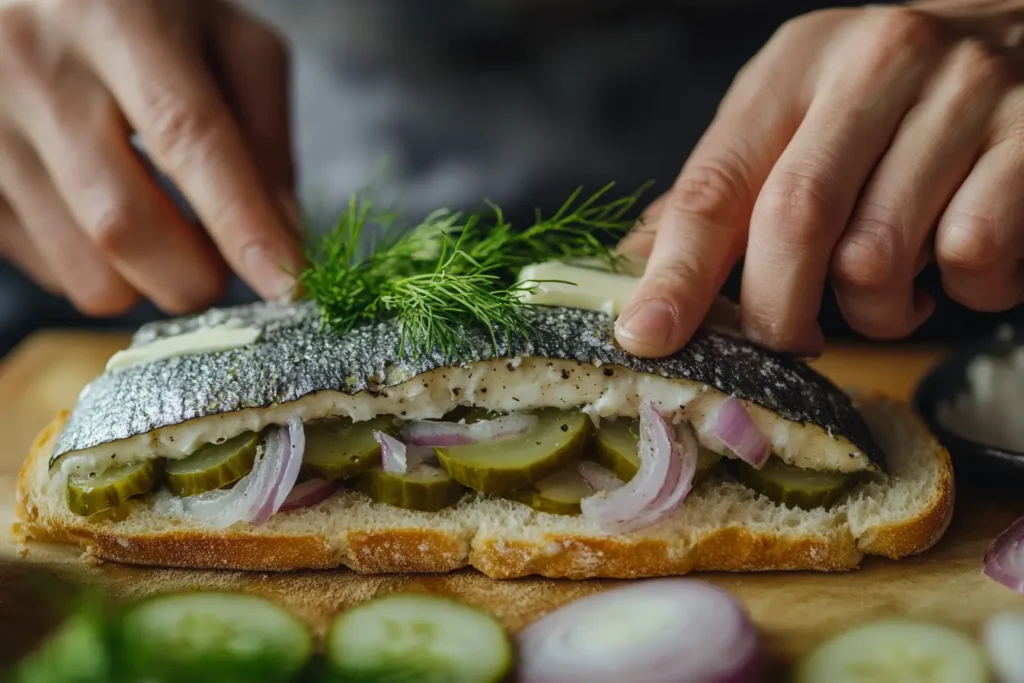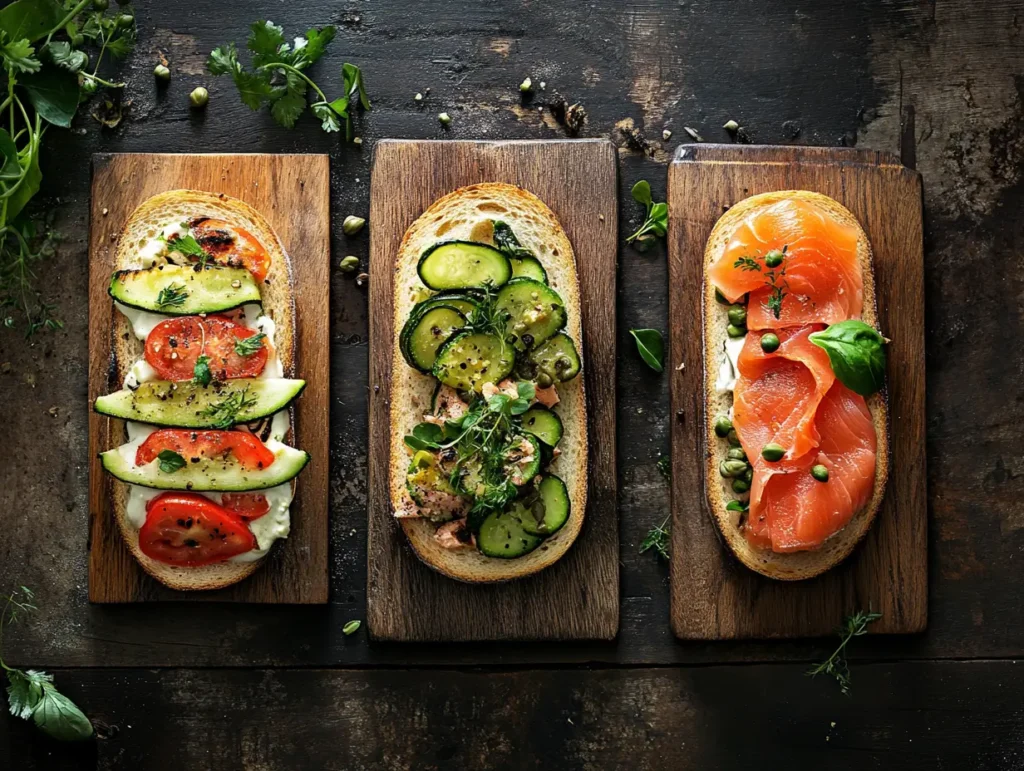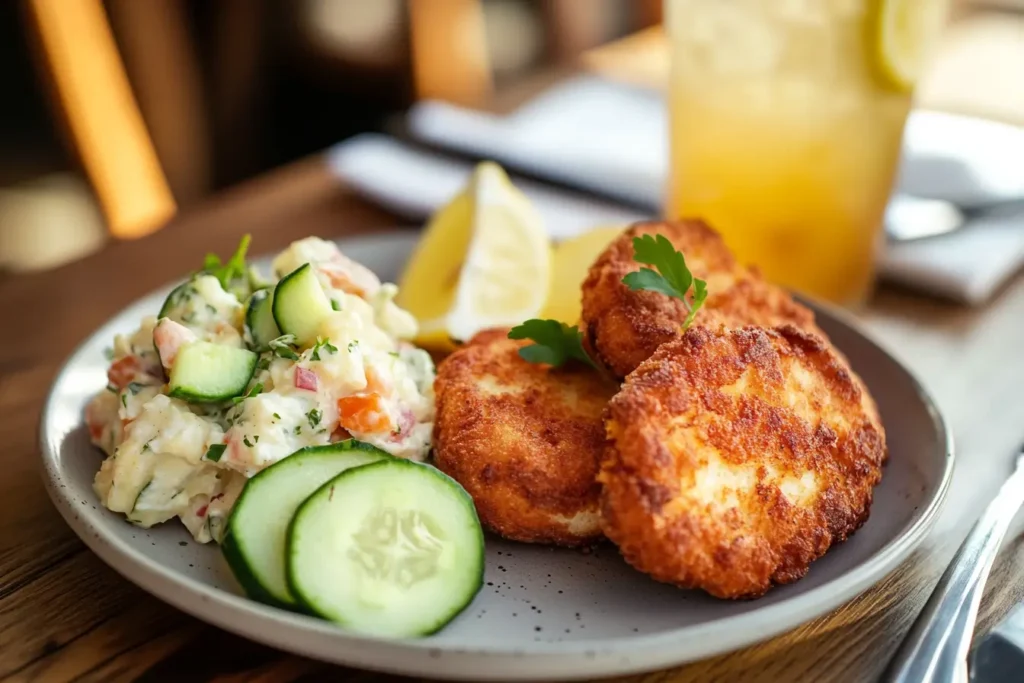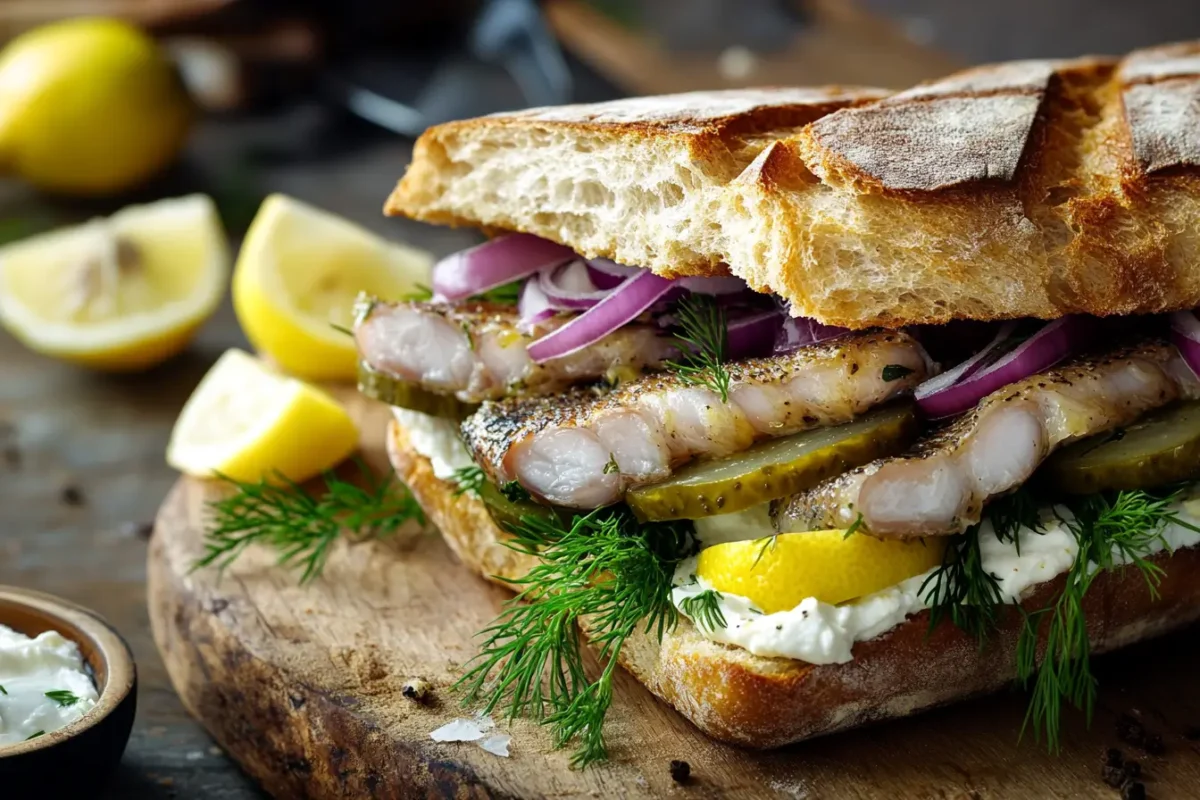Looking for a taste of Germany? 🌟 Dive into this authentic Matjesbrötchen recipe and savor the fresh, tangy flavors of this beloved fish sandwich!
Matjesbrötchen, a traditional German dish, is much more than just a sandwich—it’s a symbol of Germany’s coastal cuisine. With its tangy, savory flavors, it has become a staple in seaside markets, street food stalls, and summer picnics. At its heart lies Matjes herring, a young, lightly pickled fish known for its buttery texture and mild sweetness. Paired with crusty bread rolls, pickles, onions, and fresh dill, the Matjesbrötchen recipe is a delightful fusion of simplicity and bold taste.
In Northern Germany, Matjesbrötchen is considered a must-try dish for locals and visitors alike. Whether you’ve strolled through Hamburg’s bustling fish markets or enjoyed a sunny day by the North Sea, this classic sandwich encapsulates the flavors and traditions of the region. In this article, you’ll learn how to recreate this iconic dish at home, complete with tips, variations, and serving suggestions. Let’s dive into the ultimate Matjesbrötchen recipe, ensuring you capture its authentic taste in every bite.
Table of Contents
Cultural Background and Taste Profile
Cultural Background:
Matjesbrötchen has deep roots in Germany’s maritime culture, especially in the northern regions where fishing has been a vital industry for centuries. The term “Matjes” comes from the Dutch word “maatjesharing”, referring to young, mild herring that hasn’t spawned yet. Traditionally, the fish is caught in early summer and preserved through a gentle curing process that retains its tenderness.
- Seafaring Tradition: Historically, preserved fish like Matjes provided essential nutrition for sailors during long voyages. Over time, it became a coastal delicacy enjoyed during festivals and at bustling fish markets.
- Popular at Festivals: Matjes season is celebrated with festivals in Northern Germany, such as the Matjesfest in Emden, where locals and tourists gather to enjoy fresh Matjesbrötchen.
- Symbol of Northern Identity: The sandwich reflects Northern Germany’s deep connection to the sea, fishing traditions, and simple, hearty food.
Taste Profile:
- Mild and Buttery: Unlike heavily salted herring, Matjes is young and lightly cured, giving it a soft, buttery texture and a mild, slightly sweet flavor.
- Savory and Tangy: The addition of raw onions, crisp pickles, and sometimes apple slices or creamy sauces adds layers of sharpness, crunch, and tang, perfectly balancing the fish.
- Fresh and Satisfying: Served in a soft roll, the overall taste is refreshing and not overly heavy, making it perfect for a quick, flavorful meal.
Matjesbrötchen captures the essence of Northern German cuisine: simple, fresh, and deeply connected to local traditions.
Ingredients for the Best Matjesbrötchen Recipe
To make the perfect Matjesbrötchen recipe, start with fresh, high-quality ingredients. Here’s what you’ll need for four servings:

Main Ingredients
- 4 fresh Matjes herring fillets (lightly marinated, not smoked)
- 4 crusty Brötchen (German bread rolls) or any sturdy, crusty bread
- 1 medium red onion, thinly sliced
- 4 small pickles, sliced lengthwise
- Fresh dill sprigs for garnish
- 1 lemon (for juice and wedges)
- Butter or cream cheese for spreading
Optional Additions
- A dollop of horseradish or sour cream
- Sliced beetroot for extra color and flavor
- A pinch of smoked paprika for garnish
How to Select the Best Ingredients for Your Matjesbrötchen Recipe
Choosing the freshest ingredients is key to achieving the authentic taste of a Matjesbrötchen recipe. When selecting Matjes herring, look for fillets that are shiny and firm, with a mild aroma. The bread should have a crusty exterior and soft interior to hold the fillings without becoming soggy. Red onions are preferred for their sweetness, but white onions can work in a pinch. Adding fresh dill and a squeeze of lemon juice elevates the dish with brightness and aroma.
Step-by-Step Guide to Make the Perfect Matjesbrötchen Recipe
Making Matjesbrötchen at home may seem intimidating, but the process is straightforward. Follow these simple steps to recreate this beloved German fish sandwich:
Step 1: Prepare the Matjes Herring
Start by rinsing the Matjes herring fillets under cold water to remove any excess brine. Pat them dry with a paper towel to avoid soggy sandwiches. If the fillets are too large for the rolls, slice them in half for a better fit.
Step 2: Prepare the Vegetables and Bread
Thinly slice the red onion and soak it in ice water for 10 minutes. This reduces its sharpness while keeping its crunch. Slice the pickles lengthwise into strips. Cut the bread rolls lengthwise without cutting all the way through, so they hold together better. Lightly toast the bread rolls for added texture, then spread butter or cream cheese on each side for a creamy base.
Step 3: Assembling Your Matjesbrötchen Like a Pro
- Place a Matjes herring fillet on the bottom half of each bread roll.
- Add a layer of sliced onions and pickles on top of the herring.
- Sprinkle fresh dill generously over the toppings.
- Squeeze a little lemon juice over everything to brighten the flavors.

Step 4: Finishing Touches
Optional toppings, such as horseradish or sour cream, can be added for extra creaminess and spice. If desired, garnish with a pinch of smoked paprika or an additional sprig of dill for visual appeal.
Step 5: Serving Suggestions for the Matjesbrötchen Recipe
Serve your Matjesbrötchen immediately for the best taste. Pair with a cold drink like sparkling water or German beer to complement the sandwich’s tangy flavors.
Transitioning from preparation to enjoying the dish, take a moment to appreciate how the simplicity of these ingredients combines into a harmonious balance of textures and flavors. This step-by-step Matjesbrötchen recipe ensures success, even for beginners.
/sh
Tips for a Delicious Matjesbrötchen Sandwich
Perfecting your Matjesbrötchen recipe requires a few insider tips. First, always pat the Matjes herring dry to avoid soggy bread. If you’re short on time, assemble the sandwiches just before serving to maintain freshness. When balancing flavors, consider marinating the onions in vinegar for an added tang that complements the fish. For storage, keep leftover Matjes fillets in their brine and refrigerate them for up to two days.
When it comes to pairing, Matjesbrötchen shines alongside German potato salad, cucumber-dill salad, or even crispy fries. These side dishes enhance the sandwich’s flavors and create a well-rounded meal. If you’re hosting a gathering, serve mini versions of Matjesbrötchen as sliders for an impressive appetizer. With these tips in mind, your Matjesbrötchen recipe is guaranteed to impress.
The Story Behind Matjesbrötchen Recipe– A German Fish Sandwich
The history of Matjesbrötchen is rooted in the coastal regions of Northern Germany and the Netherlands. The word “Matjes” comes from the Dutch term for “maiden herring,” referring to young, pre-spawning fish that are prized for their delicate texture. This curing tradition dates back centuries and has become an integral part of German street food culture.
Matjesbrötchen became popular as a quick and satisfying snack for workers in port cities like Hamburg and Bremen. The sandwich’s affordability and portability made it a staple in these bustling areas. Over time, it gained a reputation as a must-try dish for travelers seeking authentic German flavors. Whether enjoyed during summer festivals or as a simple dinner, Matjesbrötchen remains a symbol of Germany’s rich culinary heritage.
Variations of the Traditional Matjesbrötchen Recipe
While the traditional Matjesbrötchen recipe is iconic, there’s plenty of room for creativity. Here are some variations to try:

- Alternative Fish Options
If Matjes herring isn’t available, smoked herring or even smoked salmon can be used as substitutes. Each option adds its own unique flavor to the sandwich. - Vegetarian Version
Replace the herring with marinated eggplant or grilled zucchini slices for a plant-based twist. These ingredients mimic the tangy and savory notes of Matjes. - Regional Twists
- In Southern Germany, beetroot and horseradish are common additions for an earthy flavor.
- Scandinavian-inspired versions might include dill-infused cream cheese or capers for added brininess.
- Spread Variations
Experiment with spreads like garlic aioli, mustard, or tzatziki to enhance the sandwich’s flavor profile. For a spicier kick, try a chili-infused mayonnaise.
These creative variations not only allow you to tailor the Matjesbrötchen recipe to your unique taste preferences but also ensure that its traditional essence is preserved. Additionally, they provide an opportunity to experiment with flavors, textures, and ingredients, making the dish even more enjoyable. Whether you prefer a classic take or a customized version, these ideas guarantee a delicious result every time.
Serving Suggestions
Matjesbrötchen isn’t just a sandwich—it’s an experience. To elevate your dining experience, consider these serving suggestions:

- As a Light Dinner: Pair with a side of German potato salad and a glass of Riesling for a well-rounded meal.
- At a Gathering: Serve mini Matjesbrötchen sliders with a platter of fresh lemon wedges and dill for garnish. They’re a hit at parties and picnics.
- For Lunch: Enjoy Matjesbrötchen with a crisp green salad and a refreshing iced tea. It’s perfect for a quick, satisfying midday meal.
Presentation matters too. Arrange the sandwiches on a wooden board with pickles, dill sprigs, and lemon wedges for a rustic, inviting look.
Frequently Asked Questions (FAQs)
Can I Substitute the Fish?
Absolutely! Fish can be easily substituted in recipes based on your taste preferences, dietary needs, or ingredient availability. When substituting fish, it’s important to consider the texture, flavor, and cooking method of the original fish to ensure the dish turns out well.
- Texture and Firmness
- Firm, Meaty Fish: If the recipe calls for firm fish like salmon, tuna, or cod, you can substitute it with halibut, mahi-mahi, or swordfish. These types hold up well in grilling, baking, or pan-searing.
- Delicate, Flaky Fish: For softer, flaky fish like tilapia or sole, substitutes like flounder, haddock, or catfish work well, especially for frying or steaming.
- Flavor Profile
- Mild-Tasting Fish: White fish like cod, haddock, or tilapia are interchangeable due to their mild flavor.
- Rich, Oily Fish: If the recipe calls for oily fish like salmon or mackerel, you can swap them for trout or Arctic char, which have similar fat content and flavor.
- Plant-Based Alternatives
- For vegetarian or vegan options, consider tofu, jackfruit, or hearts of palm for a similar texture in fish-based dishes.
- Vegan fish fillets made from soy or wheat protein can also be used for traditional seafood recipes.
- Cooking Method Compatibility
- Ensure that the substitute can withstand the same cooking method. For example, delicate fish might fall apart on the grill but work well in soups or baked dishes.
How to Store Leftovers for Maximum Freshness
Proper storage of leftovers is essential for preserving their taste, texture, and safety. Here’s how to maximize the freshness of your leftovers:
- Cool Food Quickly
- Let hot food cool for about 15–30 minutes before storing to prevent condensation, which can make food soggy.
- Divide large portions into smaller containers to cool faster.
- Use Airtight Containers
- Store leftovers in airtight glass or plastic containers to prevent air exposure, which can cause spoilage.
- Avoid keeping food in the pot or pan it was cooked in, as it may not seal properly.
- Label and Date
- Write the date on containers to track how long leftovers have been stored. This helps avoid eating spoiled food.
- Refrigerate Promptly
- Store leftovers in the refrigerator within two hours of cooking. Perishable items like fish should be stored even sooner.
- Keep the fridge temperature at or below 40°F (4°C) to slow bacterial growth.
- Freezing for Long-Term Storage
- For longer storage, freeze leftovers in freezer-safe containers or resealable bags.
- Use freezer labels to note the date. Most cooked dishes can be frozen for up to 2-3 months.
- Reheating Safely
- Reheat leftovers to an internal temperature of 165°F (74°C) to ensure safety.
- When reheating fish, do so gently in the oven or stovetop to prevent it from drying out.
- Avoid Repeated Reheating
- Only reheat the portion you intend to eat. Repeated reheating can degrade the quality and safety of food.
By following these storage tips, your leftovers will stay fresh, flavorful, and safe to eat!staurants or chains have secret menus popularized by fans or insiders. If Larry’s refers to a specific restaurant or café, additional context would help clarify the exact offerings.
Conclusion
Matjesbrötchen is a timeless authentic German sandwich recipe that combines fresh, simple ingredients into a flavorful masterpiece. This easy Matjesbrötchen guide makes it simple to enjoy a taste of Northern Germany in your own home. Whether you’re hosting a party or looking for a quick lunch, this traditional sandwich will surely impress.
Related Recipes to Explore
Expand your culinary repertoire with these dishes:
- Learn how to make crispy dumplings with this Rice Paper Dumplings Recipe.
- For a seafood twist, check out this Greek-Style Roasted Branzino Recipe.
- Dive into desserts with this Cinnamon Roll Cheesecake.
- Discover how to make Bubba’s Dinner Rolls.

